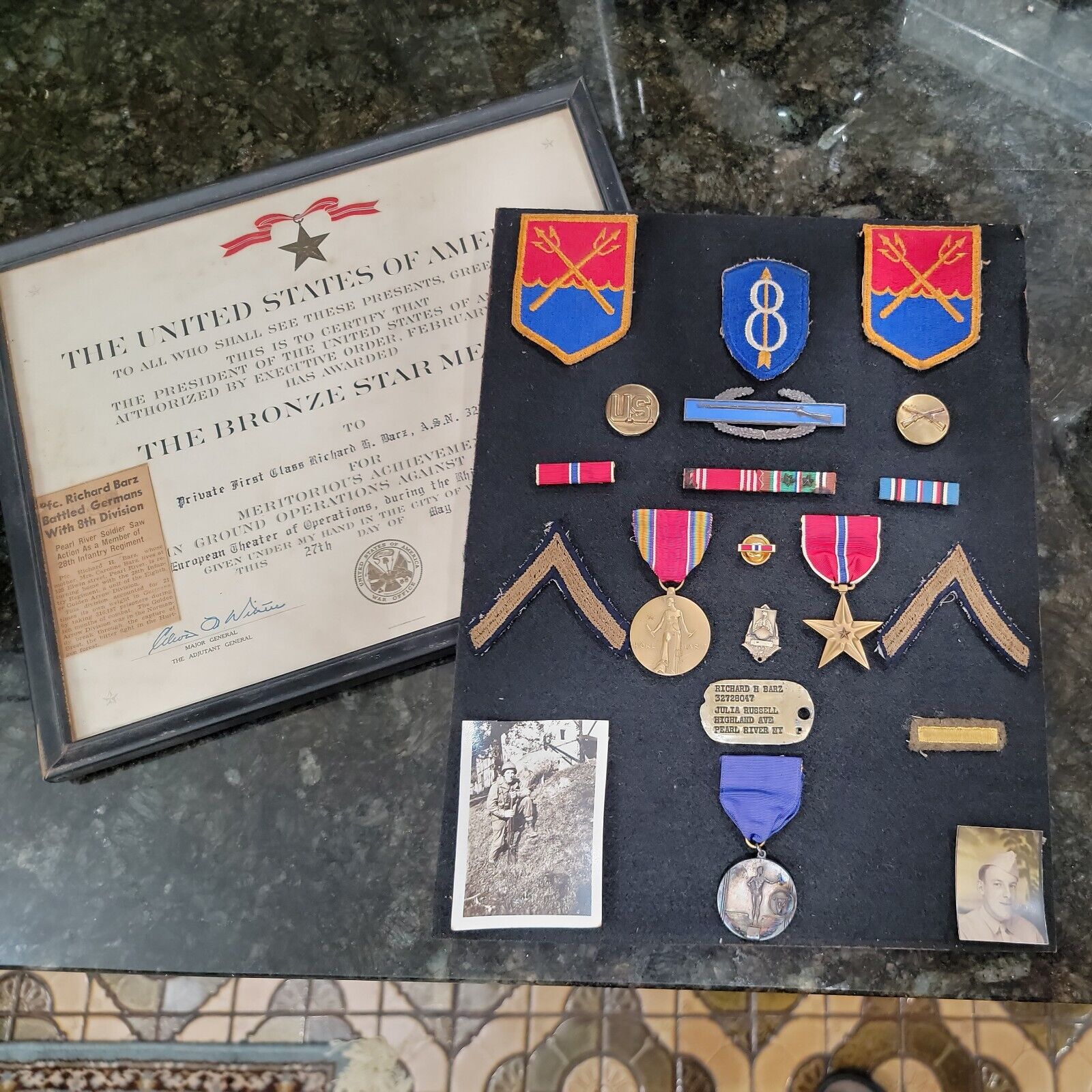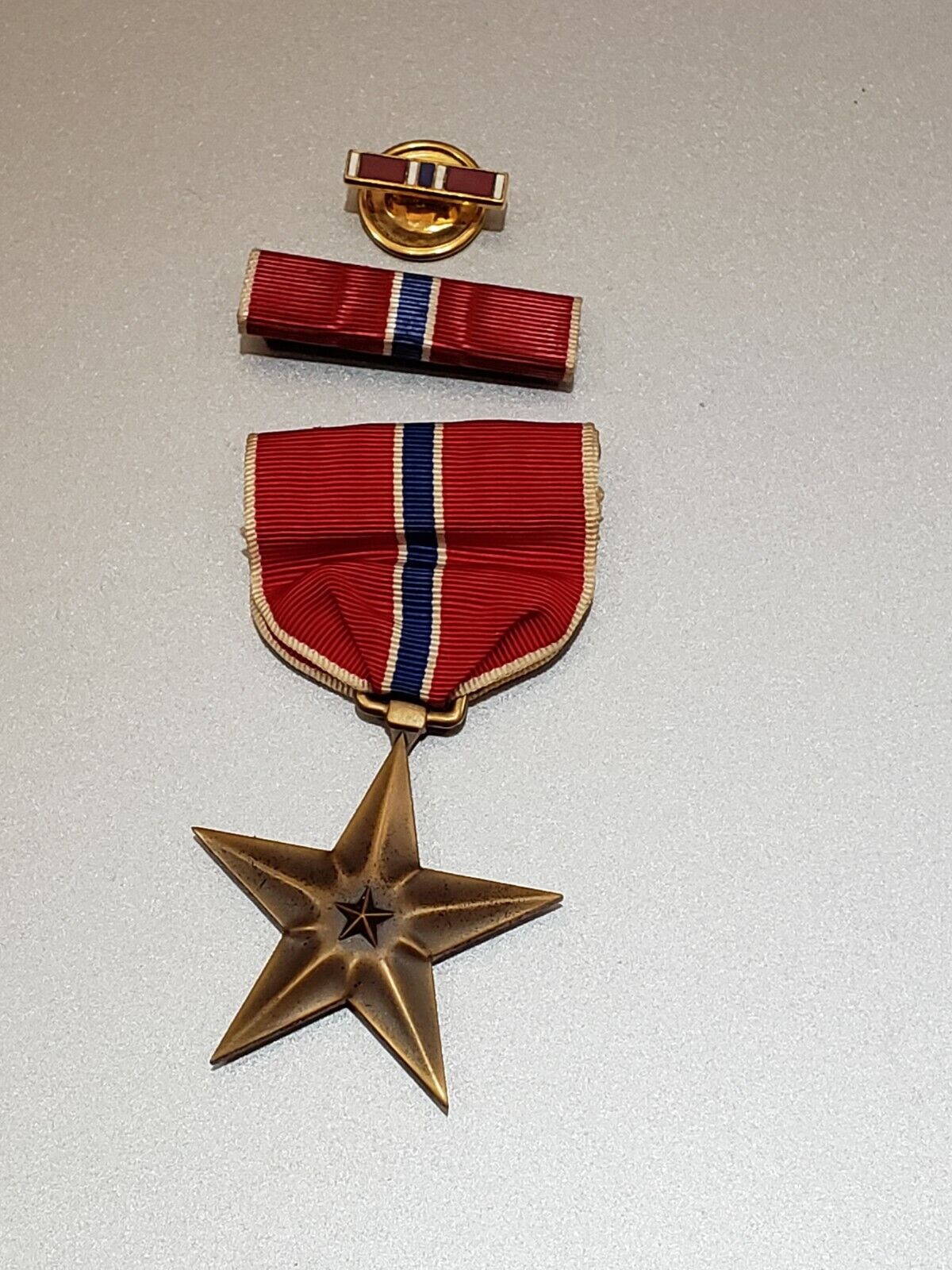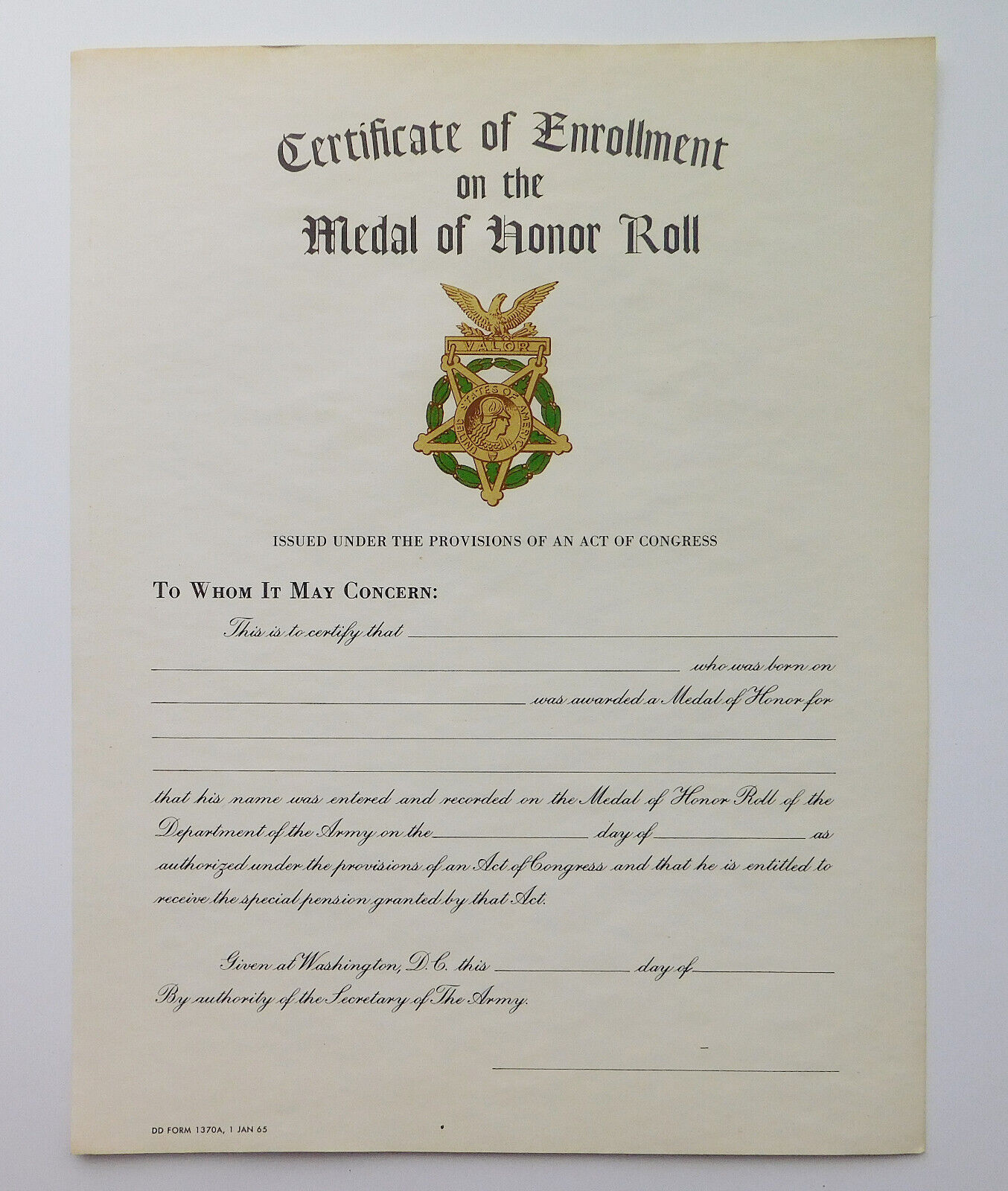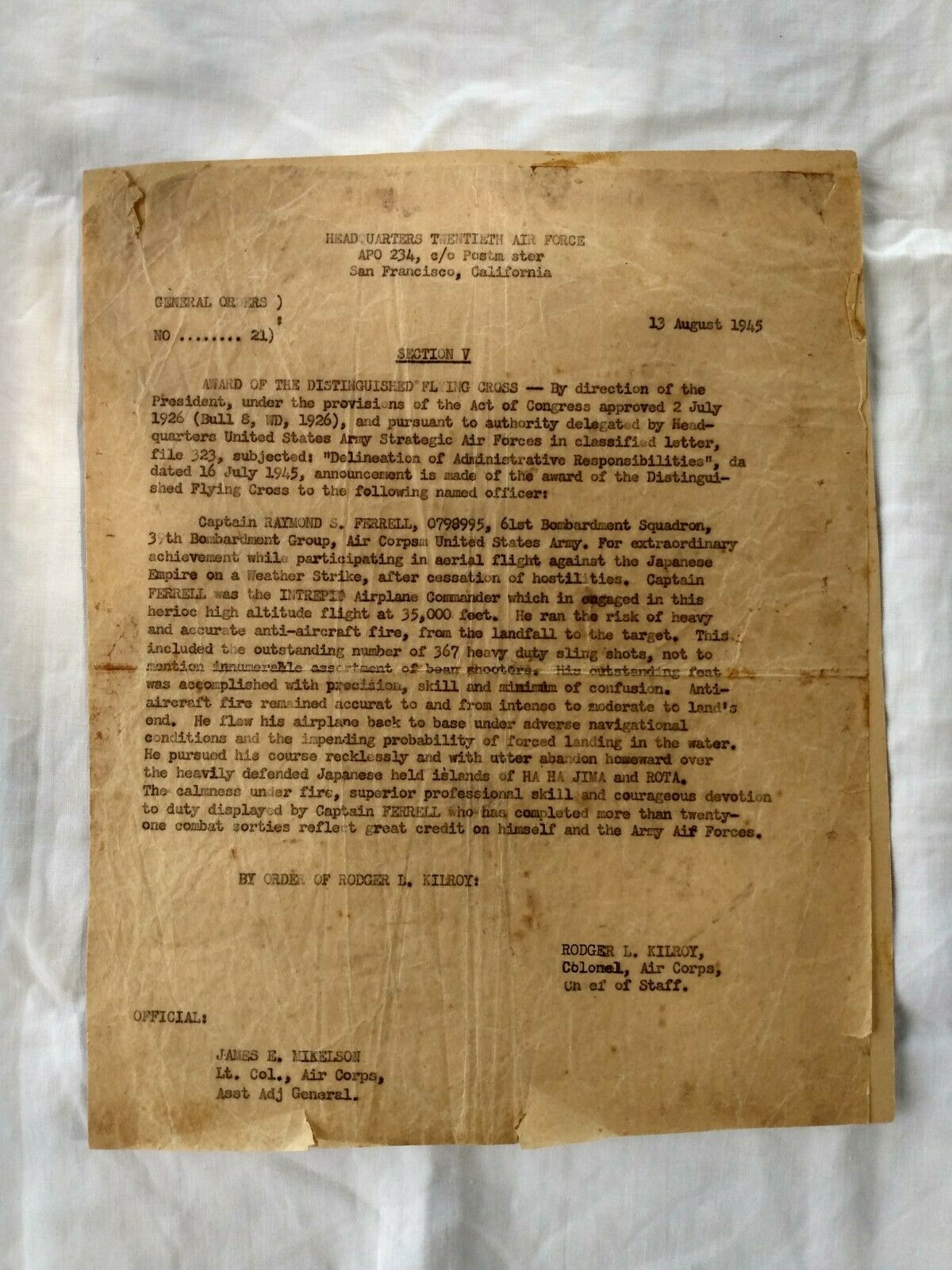need help?
[email protected]Lot Of Vintage World War II WW2 Medals Pins Patches Award Cert - 8th Infantry
$242.87 $404.79
- Product Code:
- Availability: 75
- Price in reward points: 2717
- 1000 Units in Stock
- Modified Item:No
- Original/Reproduction:Original
- Conflict:WW II (1939-45)
- Theme:Militaria
- Condition:Used
- Region of Origin:United States
Here is an opportunity of a lifetime. This militaria lot has great provenance, and a solid background. This listing includes items as photographed. The framed award, and the framed collage which includes (all that is photographed), the dog tag, photos, medals, pins, patches. It has weight, so shipping costs is priced modest, I will pay whatever difference there might be, but it will ship ground. If you want it unframed, let me know in advance. Items might shift or loosen (the dog tag already slipped from its place inside the frame) so please keep that in mind. It is old, you might need to re-sceure the items inside the frame. Sold as is with ay imperfections. Let's be real, this is a nice piece of history.
The 8th Infantry Division was recognized as a liberating unit by the U.S. Army's Center of Military History and the United States Holocaust Memorial Museum in 1988.
As you can see from the newspaper clippings, Private First Class Richard Bartz was from Pearl River NY (Rockland County), he was with the 8th Division. He battled the Germans in WWII as a member of the 28th infantry regiment - a unit of the 8th or known as the Golden Arrow Division. This division accounted for 21 times its own weight by taking 316,187 prisoners during 10 months of combat. The division was in the Normandy breakthrough, the capture of Brest, the bitter fight in the Hurtgen forest. PFC Bartz, participated in the battle of the Rhineland and battle of central Germany. He was awarded the Combat infantryman's badge, the ETO medal with two gold battle stars, Bronze star medal, and good conduct medal. Barz attended Pearl River high school and worked at Lederle Laboratories before entering the service in 1943.
Results from Wikipidia below -
World War
II
The 28th Infantry again distinguished itself in combat during World War II as part of the
8th Infantry Division
. After landing on
Utah Beach
on 4 July 1944, its first action was an attack to the south to establish a critical bridgehead over the Ay River so that armored divisions could launch a breakout and then attack into Brittany and Northern France. During its ten months of combat, the regiment played a major part in four allied campaigns – winning three Presidential Unit Citations embroidered Normandy, Bergstein and Stockheim. It captured over 115,000 prisoners and vast stores of enemy material.
Between wars
The 8th Division officially demobilized at
Camp Lee
,
Virginia
, in September 1919. The division was partially reconstituted on 24 March 1923, allotted to the Third
Corps Area
for mobilization purposes, and assigned to the
III Corps
.
Camp George G. Meade
, Maryland, was its designated mobilization station for reactivation. The 16th Infantry Brigade (12th and 34th Infantry Regiments), the 1st Battalion, 16th Field Artillery Regiment, the 15th Ordnance Company, and the 8th Tank Company (Light) were assigned to the division in October 1933 as Regular Army active units and formed the force from which the remainder of the division would be reactivated in the event of war. The commanding general of the brigade was considered the division commander for planning purposes. The 16th Infantry Brigade was stationed at
Fort Howard
, Maryland, from 1922 to 1928;
Fort Hunt
, Virginia, from 1928 to 1931; in
Washington, D.C.
, from 1931 to 1936; and at Fort Meade from 1936 to the activation of the division.
The division headquarters was organized in April 1926 at Philadelphia, Pennsylvania, as a Regular Army Inactive unit using personnel of the
Organized Reserve
, and by mid-1927, most of the division's other inactive elements were also organized as such. The active units of the division conducted annual training with the III and
XIII Corps
and the
79th
,
80th
, and
99th Divisions
. Summer training camps were usually conducted at Camp Meade.
[3]
The 16th Infantry Brigade's 12th and 34th Infantry Regiments, reinforced by the
3d Cavalry
and the
District of Columbia National Guard
's 260th Coast Artillery, were called out on 28 July 1932 to quell potential trouble from the
Bonus Army
in
Washington, D.C.
The 12th Infantry was ordered to clear the
United States Capitol
and the camps on the
Anacostia Flats
of the veterans that afternoon.
[3]
From June 1936 to August 1937, the 16th Brigade was commanded by
Lorenzo D. Gasser
, who went on to serve as the army's assistant chief of staff for personnel (G-1) and
Deputy Chief of Staff of the United States Army
.
[4]
The division was also provisionally organized in 1939 for the
First Army
Maneuvers at
Manassas, Virginia
, with the 16th Brigade reinforced by the
66th Infantry (Light Tanks)
. In preparation for becoming a "triangular" division, the 8th Infantry Division was reactivated on 1 July 1940 at
Fort Jackson
,
South Carolina
, without its Reserve units and assigned to the
I Corps
.
World War II
[
edit
]
Activated
: 1 July 1940 at Camp Jackson, South Carolina
'
Trained
at Fort Leonard Wood, Missouri in late 1942
'
Trained
at
Camp Laguna
in Arizona in 1943
Overseas
: 5 December 1943
Campaigns
:
Normandy
Northern France
Rhineland
Central Europe
Days of combat
: 266.
Distinguished Unit Citations
: 5
Combat chronicle
[
edit
]
During World War II, the 8th Infantry Division was sent to Europe to fight against the Axis. After training in Northern Ireland the 8th Infantry Division landed on
Utah Beach
,
Normandy
, 4 July 1944, and entered combat on 7 July. Shortly after its arrival, the division captured the French cities of Rennes
[5]
and Brest.
[6]
Fighting through the hedgerows, it crossed the
Ay River
, 26 July, pushed through
Rennes
, 8 August, and attacked
Brest, France
in September. When U.S. Brigadier General
Charles Canham
, who was at the time the deputy commander of the 8th Infantry Division, arrived to accept the surrender of German troops in Brest, the commander of the Brest garrison, General
Hermann-Bernhard Ramcke
asked the lower-ranking man to show his credentials. Canham pointed to his nearby troops and said "These are my credentials". That phrase has since become the 8th Infantry Division's motto.
American infantrymen of Company I, 121st Infantry Regiment move through Hurtgen, Germany, on their way to the front lines, December 1944.
Following these actions, the 8th turned eastward toward the German border, taking part in the heavy fighting in the Hürtgen Forest in November 1944. The Crozon Peninsula was cleared on 19 September, and the division drove across France to
Luxembourg
, moved to the
Hürtgen Forest
, 20 November, cleared Hürtgen on the 28th and Brandenberg, 3 December, and pushed on to the
Roer
.
[6]
That river was crossed on 23 February 1945, Duren taken on the 25th and the Erft Canal crossed on the 28th. The 8th reached the
Rhine
near Rodenkirchen, 7 March, and maintained positions along the river near
Koeln
.
[7]
In early March 1945, the 8th had advanced into the Rhineland. It fought its way into the Ruhr region the following month.
On 6 April the division attacked northwest to aid in the destruction of enemy forces in the
Ruhr Pocket
, and by the 17th had completed its mission. After security duty, the division, under operational control of the
British Second Army
, drove across the
Elbe
, 1 May, and penetrated to
Schwerin
when the war in Europe ended.
On 2 May 1945, as it advanced into northern Germany, the 8th Infantry Division encountered the
Neuengamme concentration camp
Wöbbelin subcamp
, near the city of
Ludwigslust
.
[6]
The SS had established Wöbbelin in early February 1945 to house concentration camp prisoners who had been evacuated from other Nazi camps to prevent their liberation by the Allies. Wöbbelin held some 5,000 inmates, many of whom suffered from starvation and disease. The sanitary conditions at the camp when the 8th Infantry Division and the
82nd Airborne Division
arrived were deplorable. There was little food or water, and some prisoners had resorted to cannibalism. In the first week after liberation, more than 200 inmates died. In the aftermath, the United States Army ordered the townspeople in Ludwigslust to visit the camp and bury the dead.
[6]
The 8th Infantry Division was recognized as a liberating unit by the U.S. Army's Center of Military History and the United States Holocaust Memorial Museum in 1988.
Casualties
Total battle casualties:
13,986
Killed in action:
2,532
Wounded in action:
10,057
Missing in action:
729
Prisoner of war:
668
8th Infantry Division (United States) - Wikipedia
The 8th Infantry Division was recognized as a liberating unit by the U.S. Army's Center of Military History and the United States Holocaust Memorial Museum in 1988.
As you can see from the newspaper clippings, Private First Class Richard Bartz was from Pearl River NY (Rockland County), he was with the 8th Division. He battled the Germans in WWII as a member of the 28th infantry regiment - a unit of the 8th or known as the Golden Arrow Division. This division accounted for 21 times its own weight by taking 316,187 prisoners during 10 months of combat. The division was in the Normandy breakthrough, the capture of Brest, the bitter fight in the Hurtgen forest. PFC Bartz, participated in the battle of the Rhineland and battle of central Germany. He was awarded the Combat infantryman's badge, the ETO medal with two gold battle stars, Bronze star medal, and good conduct medal. Barz attended Pearl River high school and worked at Lederle Laboratories before entering the service in 1943.
Results from Wikipidia below -
World War
II
The 28th Infantry again distinguished itself in combat during World War II as part of the
8th Infantry Division
. After landing on
Utah Beach
on 4 July 1944, its first action was an attack to the south to establish a critical bridgehead over the Ay River so that armored divisions could launch a breakout and then attack into Brittany and Northern France. During its ten months of combat, the regiment played a major part in four allied campaigns – winning three Presidential Unit Citations embroidered Normandy, Bergstein and Stockheim. It captured over 115,000 prisoners and vast stores of enemy material.
Between wars
The 8th Division officially demobilized at
Camp Lee
,
Virginia
, in September 1919. The division was partially reconstituted on 24 March 1923, allotted to the Third
Corps Area
for mobilization purposes, and assigned to the
III Corps
.
Camp George G. Meade
, Maryland, was its designated mobilization station for reactivation. The 16th Infantry Brigade (12th and 34th Infantry Regiments), the 1st Battalion, 16th Field Artillery Regiment, the 15th Ordnance Company, and the 8th Tank Company (Light) were assigned to the division in October 1933 as Regular Army active units and formed the force from which the remainder of the division would be reactivated in the event of war. The commanding general of the brigade was considered the division commander for planning purposes. The 16th Infantry Brigade was stationed at
Fort Howard
, Maryland, from 1922 to 1928;
Fort Hunt
, Virginia, from 1928 to 1931; in
Washington, D.C.
, from 1931 to 1936; and at Fort Meade from 1936 to the activation of the division.
The division headquarters was organized in April 1926 at Philadelphia, Pennsylvania, as a Regular Army Inactive unit using personnel of the
Organized Reserve
, and by mid-1927, most of the division's other inactive elements were also organized as such. The active units of the division conducted annual training with the III and
XIII Corps
and the
79th
,
80th
, and
99th Divisions
. Summer training camps were usually conducted at Camp Meade.
[3]
The 16th Infantry Brigade's 12th and 34th Infantry Regiments, reinforced by the
3d Cavalry
and the
District of Columbia National Guard
's 260th Coast Artillery, were called out on 28 July 1932 to quell potential trouble from the
Bonus Army
in
Washington, D.C.
The 12th Infantry was ordered to clear the
United States Capitol
and the camps on the
Anacostia Flats
of the veterans that afternoon.
[3]
From June 1936 to August 1937, the 16th Brigade was commanded by
Lorenzo D. Gasser
, who went on to serve as the army's assistant chief of staff for personnel (G-1) and
Deputy Chief of Staff of the United States Army
.
[4]
The division was also provisionally organized in 1939 for the
First Army
Maneuvers at
Manassas, Virginia
, with the 16th Brigade reinforced by the
66th Infantry (Light Tanks)
. In preparation for becoming a "triangular" division, the 8th Infantry Division was reactivated on 1 July 1940 at
Fort Jackson
,
South Carolina
, without its Reserve units and assigned to the
I Corps
.
World War II
[
edit
]
Activated
: 1 July 1940 at Camp Jackson, South Carolina
'
Trained
at Fort Leonard Wood, Missouri in late 1942
'
Trained
at
Camp Laguna
in Arizona in 1943
Overseas
: 5 December 1943
Campaigns
:
Normandy
Northern France
Rhineland
Central Europe
Days of combat
: 266.
Distinguished Unit Citations
: 5
Combat chronicle
[
edit
]
During World War II, the 8th Infantry Division was sent to Europe to fight against the Axis. After training in Northern Ireland the 8th Infantry Division landed on
Utah Beach
,
Normandy
, 4 July 1944, and entered combat on 7 July. Shortly after its arrival, the division captured the French cities of Rennes
[5]
and Brest.
[6]
Fighting through the hedgerows, it crossed the
Ay River
, 26 July, pushed through
Rennes
, 8 August, and attacked
Brest, France
in September. When U.S. Brigadier General
Charles Canham
, who was at the time the deputy commander of the 8th Infantry Division, arrived to accept the surrender of German troops in Brest, the commander of the Brest garrison, General
Hermann-Bernhard Ramcke
asked the lower-ranking man to show his credentials. Canham pointed to his nearby troops and said "These are my credentials". That phrase has since become the 8th Infantry Division's motto.
American infantrymen of Company I, 121st Infantry Regiment move through Hurtgen, Germany, on their way to the front lines, December 1944.
Following these actions, the 8th turned eastward toward the German border, taking part in the heavy fighting in the Hürtgen Forest in November 1944. The Crozon Peninsula was cleared on 19 September, and the division drove across France to
Luxembourg
, moved to the
Hürtgen Forest
, 20 November, cleared Hürtgen on the 28th and Brandenberg, 3 December, and pushed on to the
Roer
.
[6]
That river was crossed on 23 February 1945, Duren taken on the 25th and the Erft Canal crossed on the 28th. The 8th reached the
Rhine
near Rodenkirchen, 7 March, and maintained positions along the river near
Koeln
.
[7]
In early March 1945, the 8th had advanced into the Rhineland. It fought its way into the Ruhr region the following month.
On 6 April the division attacked northwest to aid in the destruction of enemy forces in the
Ruhr Pocket
, and by the 17th had completed its mission. After security duty, the division, under operational control of the
British Second Army
, drove across the
Elbe
, 1 May, and penetrated to
Schwerin
when the war in Europe ended.
On 2 May 1945, as it advanced into northern Germany, the 8th Infantry Division encountered the
Neuengamme concentration camp
Wöbbelin subcamp
, near the city of
Ludwigslust
.
[6]
The SS had established Wöbbelin in early February 1945 to house concentration camp prisoners who had been evacuated from other Nazi camps to prevent their liberation by the Allies. Wöbbelin held some 5,000 inmates, many of whom suffered from starvation and disease. The sanitary conditions at the camp when the 8th Infantry Division and the
82nd Airborne Division
arrived were deplorable. There was little food or water, and some prisoners had resorted to cannibalism. In the first week after liberation, more than 200 inmates died. In the aftermath, the United States Army ordered the townspeople in Ludwigslust to visit the camp and bury the dead.
[6]
The 8th Infantry Division was recognized as a liberating unit by the U.S. Army's Center of Military History and the United States Holocaust Memorial Museum in 1988.
Casualties
Total battle casualties:
13,986
Killed in action:
2,532
Wounded in action:
10,057
Missing in action:
729
Prisoner of war:
668
8th Infantry Division (United States) - Wikipedia
























